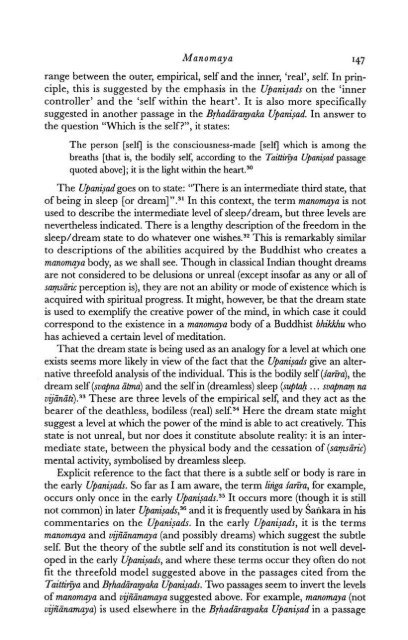Identity and Experience_Hamilton_1996
Identity and Experience_Hamilton_1996
Identity and Experience_Hamilton_1996
You also want an ePaper? Increase the reach of your titles
YUMPU automatically turns print PDFs into web optimized ePapers that Google loves.
Manomaya<br />
range between the outer, empirical, self <strong>and</strong> the inner, 'real', self. In principle,<br />
this is suggested by the emphasis in the UpaniJads on the 'inner<br />
controller' <strong>and</strong> the 'self within the heart'. It is also more specifically<br />
suggested in another passage in the Brhadiranyaka UpaniJad. In answer to<br />
the question "Which is the self?", it states:<br />
The person [selfl is the consciousness-made [selfl which is among the<br />
breaths [that is, the bodily self, according to the Taittiqa Upani~ad passage<br />
quoted above]; it is the light within the heart.30<br />
The UpaniJad goes on to state: "There is an intermediate third state, that<br />
of being in sleep [or dream]".31 In this context, the term manomaya is not<br />
used to describe the intermediate level of sleep/dream, but three levels are<br />
nevertheless indicated. There is a lengthy description of the freedom in the<br />
sleep/dream state to do whatever one wishes.32 This is remarkably similar<br />
to descriptions of the abilities acquired by the Buddhist who creates a<br />
manomaya body, as we shall see. Though in classical Indian thought dreams<br />
are not considered to be delusions or unreal (except insofar as any or all of<br />
samsiiric perception is), they are not an ability or mode of existence which is<br />
acquired with spiritual progress. It might, however, be that the dream state<br />
is used to exemplify the creative power of the mind, in which case it could<br />
correspond to the existence in a manomaya body of a Buddhist bhikWlu who<br />
has achieved a certain level of meditation.<br />
That the dream state is being used as an analogy for a level at which one<br />
exists seems more likely in view of the fact that the UpaniJads give an alternative<br />
threefold analysis of the individual. This is the bodily self (Sacra), the<br />
dream self (svapna itma) <strong>and</strong> the self in (dreamless) sleep (supta$ . . . svapnam na<br />
viinit~).~~ These are three levels of the empirical self, <strong>and</strong> they act as the<br />
bearer of the deathless, bodiless (real) self.34 Here the dream state might<br />
suggest a level at which the power of the mind is able to act creatively. This<br />
state is not unreal, but nor does it constitute absolute reality: it is an intermediate<br />
state, between the physical body <strong>and</strong> the cessation of (samsiric)<br />
mental activity, symbolised by dreamless sleep.<br />
Explicit reference to the fact that there is a subtle self or body is rare in<br />
the early UpaniJadr. So far as I am aware, the term liriga Sacra, for example,<br />
occurs only once in the early Upani~ads.~~ It occurs more (though it is still<br />
not common) in later Upanip~h,~~ <strong>and</strong> it is frequently used by Sankara in his<br />
commentaries on the Upani~ads. In the early UpaniJads, it is the terms<br />
manomaya <strong>and</strong> viiiinamaya (<strong>and</strong> possibly dreams) which suggest the subtle<br />
self. But the theory of the subtle self <strong>and</strong> its constitution is not well developed<br />
in the early UpaniSads, <strong>and</strong> where these terms occur they often do not<br />
fit the threefold model suggested above in the passages cited from the<br />
Taittimja <strong>and</strong> Brhadiiranyaka Upan4adr. Two passages seem to invert the levels<br />
of manomaya <strong>and</strong> viiiinamaya suggested above. For example, manomaya (not<br />
vciiinamaya) is used elsewhere in the Brhadirayaka Upani~ad in a passage<br />
I47


